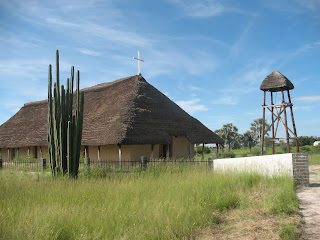 |
| Thebe River Lodge, Chobe |
Our time in Botswana was composed of staying one night in Chobe and then 2 nights in Maun on the Okavango Delta. Chobe is situated in Eastern Botswana over an hours drive from Zimbabwe. We had initially planned to stay here so that we could see the animals in style (there are more elephants in Chobe National Park then in any other part of the world). But after our fabulous experience in Etosha National Park, in northern Namibia it didn’t seem as necessary anymore. Any opportunity to save money on such a trip should be taken!
On the way to Chobe our kombi encountered a exciting, but frightful experience. We were forced to stop due to an elephant that was in the middle of the road. The elephant ruffled its ears and appeared ready to charge and continued to walk closer to us. After some fear, putting the music off and winding up the windows we waited patiently. We couldn’t move backwards as cars were right behind us. Fortunately a car drove in front of us and the elephant walked off the road. It was a close call (there were a couple in our group who had a closer one in Zimbabwe, they were on foot and had to run away from an elephant chasing after them).
 |
| Shower area- Old Bridge Backpackers, Maun |
We stayed at the Thebe River Lodge, which was a nice but somewhat isolated campsite. Everyone camped and we spent some valuable time as a group, especially learning and singing some Christian camp fire songs from Tara (our Namibian group leader who was a fabulous singer, guitarist, but also cook and was valuable to the group’s spirit). After the tents were up and food on its way, some of us decided to check out the area. The campsite was surrounded by an electric fence to protect the campers from crocodiles coming off the river banks.
The Old Bridge Backpackers in Maun was really impressive. Our campsite was right on the river and the bar area was charming with hammocks and a small pool. The public showers were spacious; each one with a large separate section, with a rope to pull across to show that it is in use. During our free day in Maun we spent almost two hours looking for the Wildlife Reserve only to find out that it was closed due to high water levels. It was rather disappointing, but we managed to fill the time with other things. I went to a museum for a bit and then got some quality street tucker. For U.S. $ I was given traditional Botswanan food of beef, rice and chakalaka (a spicy vegetable dish often served with bread, pap or a curry). This was such a great tasting meal!
 |
| Okavango Delta boat cruise |
Later on I met a guy called Mulimuntz and he offered for a friend to take us out on the river. I didn’t uptake it but instead headed back to the Backpackers for the India vs. Australia cricket game (a close game, but unfortunately the Aussies couldn’t pull through). Later on some new friends took a few of us from our group in a boat along the river. It was peaceful and surreal, but a close hippo kept us awake (after spotting it we soon moved onto another piece of water).
 |
| Open-billed stork |
 |
| marunga- traditional dugout canoe |
 |
| Claire with a water lily necklace |
At one point we got off the boat to walk in the Moremi Wildlife Reserve. Our guide pointed out some really cool things as we went through water over our knees and dry land. When elephants want to remove ticks from their bodies, they rub themselves up against trees (we saw some visible signs of this from the mud on the trees). Rex even broke open some sage for us to smell. On the way back we saw the traditional dugout wood canoe, used in Botswana called the “marunga.” Back in the boat we saw various huts, used by migrant workers to sleep. These workers utilized machetes to cut down a particular weed to make huts.Our intention was to eat lunch on the mainland. However, just as we were about to step out from the boat a baby crocodile scurried across in front of the boat. So we ended up enjoying tuna, potato and green salad on the boat. Rex showed us how to make a water lily necklace all to our amazement (it was intricately made by breaking off components to create the design and then tying each end together). Later on we saw a few hippos before finding a shallower area to swim in.
After the cruise our group enjoyed our final night in Botswana and also our spring break. It was a glorious time and the memories will continue to stay with me. What an awesome experience!













































